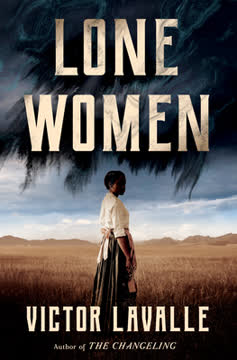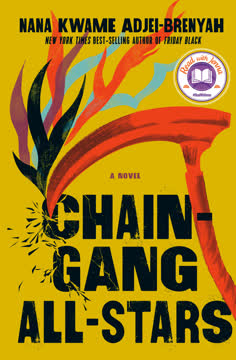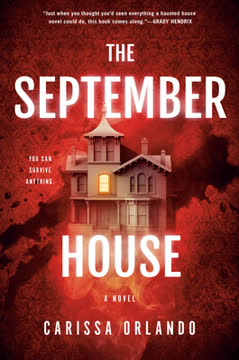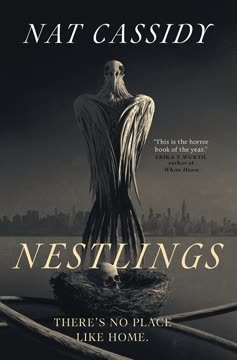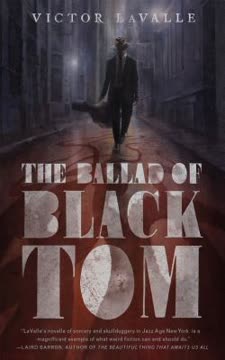Plot Summary
Adelaide's Fiery Departure
In 1915, Adelaide Henry, a Black woman burdened by her family's dark secrets, sets her California farmhouse ablaze, leaving behind the bodies of her parents. This act of arson marks her escape from a life overshadowed by shame and a mysterious family curse. As she flees, Adelaide carries a heavy steamer trunk, symbolizing the weight of her past and the creature within it. Her departure is a desperate bid for freedom and a new beginning, setting the stage for her journey to Montana.
A Journey to the Unknown
Adelaide embarks on a tense journey from California to Montana, seeking solace and redemption in the vast, open land. Her travels are marked by introspection and the haunting presence of her family's secrets. Inspired by the story of Mattie T. Cramer, a successful lone woman homesteader, Adelaide hopes to carve out a new life. However, the journey is fraught with challenges, as she grapples with her past and the uncertainty of her future.
Secrets and Shadows
Arriving in Big Sandy, Montana, Adelaide is confronted by the isolation and harshness of her new environment. She meets Grace Reed, a local woman who offers friendship and guidance. Despite the budding connections, Adelaide is haunted by the creature locked in her steamer trunk, a constant reminder of her family's curse. As she settles into her homestead, Adelaide struggles to balance her desire for a fresh start with the fear of her secret being discovered.
A New Life in Montana
Adelaide adapts to the challenges of homesteading, relying on the support of neighbors like Grace and her son, Sam. She learns to navigate the demands of securing food and preparing for winter, finding moments of community and connection. Yet, the creature's presence looms large, threatening her newfound stability. Adelaide must reconcile her inherited curse with her aspirations for freedom and belonging in this new land.
The Mudge Encounter
Adelaide's past catches up with her when the Mudge family, notorious outlaws, arrive at her homestead. The encounter turns violent, forcing Adelaide to unleash the creature she has kept hidden. The creature's monstrous nature is revealed in a terrifying display, leaving Adelaide to grapple with the aftermath. This incident shakes her sense of security and forces her to reconsider her place in the community and the legacy of her family's curse.
A Community of Lone Women
Amidst the chaos, Adelaide finds solace in the company of other women in the community. At a gathering hosted by Mrs. Reed, she is inspired by stories of resilience and determination. The event highlights the power of women supporting each other in a male-dominated world. Adelaide begins to envision a new life, one where she can forge her own path and find strength in the bonds of friendship and shared experience.
The Creature Unleashed
The creature escapes from its confinement, unleashing chaos and destruction. Adelaide is forced to confront the full extent of its power and the danger it poses to her and the community. In a desperate struggle, she manages to subdue the beast, but not before it leaves a trail of devastation. This incident forces Adelaide to reevaluate her relationship with the creature and the choices she must make to protect herself and those she cares about.
Bloodied Boys and Hidden Truths
In Big Sandy, George Shibata discovers two bloodied boys, Delmus and Joab Mudge, claiming their family was attacked by a mountain lion. The community takes them in, but Joab harbors a secret desire for revenge against the creature that killed his family. This subplot introduces new tensions and highlights the pervasive fear and suspicion within the town.
Secrets in the Attic Unveiled
Mrs. Jerrine Reed, a prominent figure in Big Sandy, reveals a dark secret to Sam, Grace's son, about a monstrous child she once bore. This revelation, shared in the attic of her home, exposes the hidden traumas and unresolved issues that haunt the town's residents. Joab's presence during this revelation adds another layer of complexity to the unfolding drama.
A Town's Reckoning Begins
Adelaide returns to Big Sandy to find the town in turmoil, with Mrs. Jerrine Reed leading a charge against her and her friends. The community's fear of the unknown manifests in a public trial, where Adelaide's past and the creature she brought with her are used against her. The town's darker instincts are laid bare as they prepare to hang Adelaide and her friends, forcing a confrontation with their own prejudices.
Elizabeth's Return and Redemption
As the nooses tighten around Adelaide and her friends, Elizabeth, Adelaide's monstrous sister, intervenes. Her presence is both terrifying and redemptive, as she spares the women and reveals the true nature of the town's fear. Elizabeth's actions force the townspeople to confront their own prejudices and the real monsters within themselves, offering a chance for redemption and change.
The Town of Two Sisters
After the chaos in Big Sandy, Adelaide, Elizabeth, and their friends find refuge in an abandoned town, which they name Two Sisters. This new community becomes a sanctuary for lone women seeking freedom and empowerment. The town thrives, becoming a testament to the strength and resilience of women who refuse to be defined by their pasts, offering hope and a new beginning.
Characters
Adelaide Henry
Adelaide is a strong, determined woman haunted by the mysterious deaths of her parents and the creature she carries with her. Her journey to Montana is both an escape and a search for redemption. Adelaide is resourceful and resilient, but her past weighs heavily on her, complicating her efforts to start anew. Her interactions with others reveal her longing for connection and the struggle to reconcile her inherited curse with her desire for freedom.
Grace Reed
Grace is a local woman who befriends Adelaide, offering guidance and companionship. She is practical and straightforward, with a keen sense of community and a willingness to help others. Grace's relationship with her son, Sam, highlights her nurturing nature and resilience. Her presence provides Adelaide with a sense of belonging and a glimpse of the supportive network of women in the area.
The Creature
The creature is a mysterious, monstrous being that has plagued Adelaide's family for generations. Its presence is a constant reminder of the secrets and shame that Adelaide carries. The creature's escape and subsequent rampage force Adelaide to confront the reality of her situation and the danger it poses to her and those around her. It symbolizes the inescapable nature of her past and the challenges she must overcome to find peace.
Joab Mudge
Joab is a complex character, torn between his past as a member of the Mudge family and his desire for a new life. His journey from a life of crime to enlisting in the Navy is marked by a deep sense of guilt and a longing for redemption. Joab's interactions with Sam and the other characters reveal his inner conflict and his struggle to find his place in the world.
Mrs. Jerrine Reed
Mrs. Jerrine Reed is a powerful figure in Big Sandy, but her past is marked by tragedy and secrets. Her attempt to impose her will on Sam reveals her own unresolved trauma and the lengths she will go to maintain control. Mrs. Jerrine Reed's character is a study in the complexities of power, fear, and the human capacity for denial.
Elizabeth Henry
Elizabeth, Adelaide's monstrous sister, is both a symbol of fear and a force for redemption. Her intervention in the town's judgment of Adelaide and her friends reveals her capacity for mercy and her desire for connection. Elizabeth's character challenges the townspeople's perceptions of monstrosity and humanity.
Sam Price
Sam is Grace's son, a bright and inquisitive boy who forms a bond with Adelaide. His innocence and curiosity provide a contrast to the darker elements of the story, highlighting the potential for hope and renewal. Sam's presence in Adelaide's life offers her a glimpse of the future she could have if she can overcome her past.
Bertie Brown
Bertie is a fellow homesteader and one of the few Black women in the area. She is strong-willed and independent, with a successful business and a deep sense of community. Bertie's friendship with Adelaide provides her with a sense of belonging and a connection to her roots. Her presence underscores the importance of solidarity and support among women in a challenging environment.
Finn Kirby
Finn is Matthew's uncle, a steady and reliable presence in his nephew's life. He is cautious and protective, with a deep sense of responsibility for those he cares about. Finn's interactions with Adelaide reveal the complexities of family dynamics and the challenges of navigating a world filled with danger and uncertainty.
Mrs. Reed
Mrs. Reed is a prominent figure in Big Sandy, known for her leadership and advocacy for women's rights. She is charismatic and influential, with a deep commitment to supporting and empowering the women in her community. Her presence at the opera house event highlights the power of collective action and the importance of creating spaces for women to connect and support one another.
Plot Devices
The Steamer Trunk
The steamer trunk is a central plot device, representing the weight of Adelaide's past and the creature she carries with her. It serves as a physical manifestation of her family's curse and the secrets she must keep hidden. The trunk's presence in the story underscores the themes of shame, guilt, and the struggle to escape one's past.
The Creature
The creature is a mysterious, monstrous being that symbolizes the inescapable nature of Adelaide's family curse. Its presence drives the narrative, forcing Adelaide to confront her past and the danger it poses to her and those around her. The creature's actions and interactions with Adelaide highlight the themes of fear, responsibility, and the struggle for redemption.
The Homestead
The homestead in Montana serves as both a place of refuge and a site of isolation for Adelaide. It represents the potential for a new beginning and the challenges of starting over in a harsh and unforgiving environment. The homestead's remote location underscores the themes of loneliness, resilience, and the search for community and belonging.
The Opera House
The opera house in Big Sandy is a gathering place for the community, representing the power of collective action and the importance of creating spaces for women to connect and support one another. It serves as a backdrop for key events in the story, highlighting the themes of solidarity, empowerment, and the potential for change in a male-dominated world.
Analysis
"Lone Women" by Victor LaValle is a powerful exploration of the themes of isolation, community, and the struggle for redemption. Through Adelaide's journey, the novel delves into the complexities of inherited curses and the weight of family secrets. The story highlights the resilience of women in the face of adversity and the importance of solidarity and support in overcoming challenges. The creature, a manifestation of Adelaide's past, serves as a catalyst for her transformation and the community's reckoning with its own prejudices. Ultimately, the novel is a testament to the strength and resilience of women who refuse to be defined by their pasts, offering hope and a new beginning in the town of Two Sisters.
Last updated:
FAQ
Synopsis & Basic Details
What is Lone Women about?
- A Fugitive's New Start: In 1915, Adelaide Henry, a Black woman, flees her California farm after a mysterious, violent event, carrying a locked steamer trunk and a profound secret to the harsh, isolating landscape of Montana. She seeks to homestead 320 acres, hoping to outrun her past and the "curse" that has plagued her family.
- Building Unexpected Bonds: As Adelaide navigates the challenges of homesteading, she forms tentative but vital connections with other "lone women" and their families, including the pragmatic Grace Price and her curious son Sam, and the resilient Black entrepreneur Bertie Brown and her partner Fiona Wong. These relationships offer a glimpse of community amidst the wilderness.
- Confronting Hidden Monsters: Adelaide's carefully guarded secret, a monstrous entity confined within her trunk, eventually escapes, forcing her to confront its true nature and the devastating legacy of her family's past. This unleashes a chain of events that draws her new community into a violent reckoning with both external threats and their own deeply held prejudices.
Why should I read Lone Women?
- Unique Blend of Genres: Victor LaValle masterfully weaves historical fiction with elements of horror and social commentary, offering a fresh perspective on the American West and the untold stories of marginalized homesteaders. It's a gripping narrative that challenges conventional notions of monstrosity and humanity.
- Rich Character Exploration: The novel features a cast of complex, resilient women who defy expectations and forge their own paths in a challenging world. Readers will be drawn into their struggles for survival, belonging, and self-acceptance, exploring themes of inherited trauma, identity, and the power of chosen family.
- Thought-Provoking Themes: Beyond the thrilling plot, Lone Women delves into profound questions about shame, secrets, justice, and the nature of good and evil. It examines how communities are formed and fractured, and the enduring strength found in solidarity, making it a deeply resonant and timely read.
What is the background of Lone Women?
- Historical Homesteading Context: The novel is set against the backdrop of the 1910s Montana homesteading movement, a period when the U.S. government offered 320-acre plots of land, including to single women and Black citizens, a rare opportunity for independence. This historical reality provides the foundation for the characters' struggles and aspirations.
- Racial and Gender Dynamics: Lone Women explores the unique challenges faced by Black women and other marginalized groups in the American West, highlighting the systemic racism and xenophobia (e.g., against Chinese immigrants, Indigenous peoples) prevalent at the time. It subverts the romanticized image of the frontier by focusing on those often excluded from historical narratives.
- Author's Research and Inspiration: Victor LaValle drew inspiration from historical accounts of women homesteaders, particularly those documented in books like Montana Women Homesteaders: A Field of One's Own. He fictionalizes the setting of Big Sandy, Montana, to create a narrative that blends documented history with speculative horror, aiming to give a larger audience to these often-forgotten stories.
What are the most memorable quotes in Lone Women?
- "A woman is a mule.": This mantra, frequently repeated by Adelaide's mother, Eleanor, encapsulates the generational burden of toil, sacrifice, and endurance expected of women, particularly Black women, in their harsh lives. It highlights the weight of responsibility and the often-unrewarded labor that defines their existence.
- "History is simple, but the past is complicated.": Uttered by Mrs. Reed, this quote becomes a central thematic statement, revealing the novel's core message about the selective narratives of history versus the messy, often hidden truths of individual and collective pasts. It underscores the author's intent to uncover and complicate simplified historical accounts.
- "Mudges never forget.": Spoken by Joab Mudge, this chilling declaration embodies the deep-seated desire for vengeance and the enduring nature of family loyalty and grudges, even when twisted by trauma and circumstance. It foreshadows the Mudge family's relentless pursuit of retribution and their impact on Adelaide's life.
What writing style, narrative choices, and literary techniques does Victor LaValle use?
- Gothic Western Horror: LaValle masterfully blends the stark realism of the American Western with the psychological tension and supernatural elements of Gothic horror. This creates a unique atmosphere where the external dangers of the frontier are mirrored by the internal terrors and inherited curses of the characters.
- Intimate Third-Person Perspective: The narrative primarily follows Adelaide Henry in a close third-person point of view, allowing deep access to her internal struggles, guilt, and evolving perceptions. This intimacy is occasionally broadened to other characters, providing diverse perspectives on the unfolding events and the harsh realities of their lives.
- Symbolism and Foreshadowing: LaValle employs rich symbolism, such as the steamer trunk representing Adelaide's hidden burdens and the Montana wind as an omnipresent, shaping force. Subtle foreshadowing, like Mr. Cole's early comments about the Henrys being "queer folk" or the story of the hanged man at the old hotel, builds suspense and deepens thematic resonance.
Hidden Details & Subtle Connections
What are some minor details that add significant meaning?
- Adelaide's Unexplained Hand Wounds: Early in the novel, Adelaide's hands are covered in deep cuts, the origin of which she cannot precisely recall, only that they appeared between dinner and dawn. This detail subtly foreshadows the creature's violent nature and Adelaide's repressed trauma, hinting at her active role in the initial "massacre" and her subconscious effort to erase the memory of her struggle with Elizabeth.
- The Significance of Adelaide's Books: Adelaide's small library, particularly The Tenant of Wildfell Hall and The Secret Garden, offers symbolic depth. The Tenant mirrors Adelaide's own flight from a secret, abusive past, while the torn page from The Secret Garden by Sam foreshadows the eventual unveiling of hidden truths and the potential for growth and healing in a "secret" place.
- The "Warm in Here" Motif: The recurring phrase "Warm in here, getting hotter by the minute," first spoken by the men in the Glendale saloon and later emanating from the abandoned charcoal kilns, serves as an unsettling motif. It subtly connects the men to a hidden, sinister past (the kiln deaths) and implies a predatory, escalating threat, hinting at a deeper, more pervasive evil in the land than just Adelaide's creature.
What are some subtle foreshadowing and callbacks?
- Mr. Cole's "Queer Folk" Comment: Early in Adelaide's journey, Mr. Cole labels the Henrys as "queer folk" due to their reclusiveness. This seemingly casual gossip foreshadows the deeper, monstrous secret that isolates Adelaide's family and sets the stage for the community's eventual judgment, highlighting the historical prejudice against those perceived as different.
- The Old Hotel's Hanging Story: Mr. Olsen's tale of Vardner being hanged for cattle rustling at the derelict hotel subtly foreshadows the Vigilance Committee's brutal justice and the town's willingness to resort to lynching. It establishes a precedent for swift, violent retribution, which later becomes a direct threat to Adelaide and her friends.
- Mrs. Jerrine Reed's Crib and Lost Child: Mrs. Jerrine Reed's revelation of a monstrous child she bore, kept in a cast-iron crib in her attic, serves as a powerful callback and parallel to Adelaide's own story. This shared, hidden trauma between two seemingly disparate women foreshadows their eventual, albeit complicated, alliance and underscores the novel's theme of hidden female suffering and the societal pressure to conceal "imperfections."
What are some unexpected character connections?
- Joab Mudge and Sam Price's Parallel Journeys: Joab, initially a blind outlaw, and Sam, a curious child, are unexpectedly linked by their shared experiences of trauma and their mothers' secrets. Joab's later transformation into a "Strangler" and then a Navy enlistee, and Sam's role in convincing Adelaide to spare Joab, highlight the novel's exploration of redemption and the impact of choices on identity, mirroring each other's search for belonging.
- Mrs. Jerrine Reed and Adelaide's Shared Monstrous Secret: The most unexpected connection is between Mrs. Jerrine Reed, the town's matriarch, and Adelaide. Both women secretly bore monstrous children, forced to conceal or dispose of them due to societal pressures. This shared, unspoken trauma creates a complex dynamic, initially leading to conflict but ultimately revealing a deeper, tragic understanding of the burdens placed on women.
- Clement Cardinal's Role as a Métis Ally: Clement Cardinal, the Métis trader, initially appears as a minor character delivering malt. However, his offer of safe passage to Canada for Adelaide, based solely on her being "a woman in trouble," establishes him as a crucial, unexpected ally. His perspective as an Indigenous person navigating colonial borders adds a layer of intertextual commentary on refuge and belonging beyond American and Canadian systems.
Who are the most significant supporting characters?
- Mr. Olsen, the Compassionate Wagon Driver: Mr. Olsen, initially appearing as a gruff but honest wagon driver, becomes a significant figure through his unexpected kindness and generosity towards Adelaide. His return with the Mudges' abandoned goods, sold to Adelaide at a profound discount, provides her with the essential items for survival, highlighting the unexpected acts of human decency in a harsh land.
- Carlota and Francisco, the Mountain Mystics: This small, unassuming couple living high in the Bear Paw Mountains offers Adelaide not just physical aid but also spiritual guidance. Their "sheep's milk" drink, which helps Adelaide "see more clearly," and their recognition of Elizabeth as a "goddess" provide a crucial, non-Western interpretation of the creature, shifting Adelaide's perspective from curse to something more profound and powerful.
- Clement Cardinal, the Border-Crossing Ally: Beyond his initial offer of refuge, Clement Cardinal represents a different kind of freedom and community. As a Métis trader, he navigates the borders between nations and cultures, offering a perspective that transcends the rigid societal norms of Big Sandy. His presence underscores the possibility of finding belonging and support outside conventional structures, even if Adelaide ultimately chooses a different path.
Psychological, Emotional, & Relational Analysis
What are some unspoken motivations of the characters?
- Adelaide's Desire for Absolution: While Adelaide explicitly seeks freedom from her family's curse, an unspoken motivation is her desperate longing for absolution from the guilt of her parents' deaths and her own inaction. Her confession to Grace and later to Elizabeth is a profound attempt to unburden herself, even if she doesn't consciously expect forgiveness.
- Mrs. Jerrine Reed's Need for Control and Legacy: Mrs. Jerrine Reed's relentless drive to shape Big Sandy, from the opera house to the Busy Bees, is fueled by an unspoken need for control and to establish a positive legacy. This stems from her own traumatic experience of bearing a monstrous child, which she and her husband "disposed of," leading her to project an image of order and moral authority onto the community.
- Joab Mudge's Search for a New Identity: Joab's rapid shift in loyalty from his Mudge family to Mr. Reed, and his eagerness to become a "Strangler," is driven by an unspoken desire to shed his criminal past and forge a legitimate identity. His actions, including killing his brother Delmus, are motivated by a desperate need for acceptance and a new sense of belonging, even if it means betraying his blood.
What psychological complexities do the characters exhibit?
- Adelaide's Internalized Shame and Self-Loathing: Adelaide exhibits deep psychological complexity through her internalized shame, stemming from her family's secret and her own perceived complicity in their deaths. Her initial desire for all of them to die, including Elizabeth, reveals a profound self-loathing and a desperate wish to be free from the burden, even at the cost of her own family.
- Delmus Mudge's Trauma and Confession: Delmus Mudge's trauma after witnessing his mother's death and his brothers' flight manifests as a fragile, hysteric state, leading him to drink heavily. His desperate confession to the demon, promising to "tell it all true" and expose the Mudges' crimes, highlights the psychological breaking point where the burden of secrets becomes unbearable, even for a hardened criminal.
- Grace Price's Fierce Maternal Protection: Grace's psychological complexity is rooted in her fierce, almost animalistic, protection of Sam. Her past act of killing her abusive husband, and her violent reaction to Mrs. Jerrine Reed's attempt to "adjust" Sam, reveal a deep-seated maternal instinct that overrides societal norms and personal fear, showcasing the lengths a mother will go to safeguard her child's well-being and identity.
What are the major emotional turning points?
- Adelaide's Confession to Grace: The moment Adelaide finally confesses to Grace, "I didn't come to Montana alone," marks a major emotional turning point. It's the first time she shares her deepest secret outside her family, a profound act of vulnerability that begins to dismantle her lifelong isolation and opens the door to genuine connection and the possibility of a chosen family.
- Grace's Slap to Mrs. Jerrine Reed: Grace's spontaneous slap to Mrs. Jerrine Reed, followed by her defiant declaration, "If you ask me to pick between my child and your approval, I will pick this boy every time," is a powerful emotional turning point. It signifies Grace's unwavering commitment to Sam's identity and her rejection of societal pressures, solidifying her as a fierce protector and a true ally to Adelaide.
- Adelaide's Apology to Elizabeth: Adelaide's tearful confession and apology to Elizabeth in the cave—"I wished you all were dead... I'm sorry I wasn't better to you"—is the emotional climax of their relationship. This raw, honest admission of her past resentment and regret allows for a profound shift, transforming their dynamic from jailer and prisoner to sisters, paving the way for Elizabeth's redemption and their shared future.
How do relationship dynamics evolve?
- Adelaide and Grace: From Acquaintances to Chosen Sisters: Their relationship evolves from cautious neighbors to deep, trusting friends. Initially, Grace's well-meaning but critical advice creates distance, but Adelaide's confession and Grace's subsequent defense of Sam against Mrs. Jerrine Reed forge an unbreakable bond. They become a chosen family, offering each other the support and understanding they lacked.
- Bertie and Fiona: Deepening Intimacy and Mutual Support: The relationship between Bertie and Fiona, already established as a loving partnership, deepens through shared adversity. Fiona's quiet support during Bertie's anger, their shared vulnerability after the power laundry incident, and their intimate moments underscore their profound connection. They represent a resilient, self-sufficient queer relationship thriving against the odds.
- Joab and Mr. Reed: A Transactional Loyalty to a Twisted Father Figure: Joab's relationship with Mr. Reed quickly transforms from employer-employee to a twisted form of father-son loyalty. Joab, orphaned and seeking legitimacy, pledges fealty to Reed, even committing fratricide to secure his new identity. This dynamic highlights the manipulative power of authority and the desperate measures individuals take for belonging and survival.
Interpretation & Debate
Which parts of the story remain ambiguous or open-ended?
- The Creature's True Nature and Origin: While Carlota and Francisco refer to Elizabeth as a "goddess," her exact nature and origin remain ambiguous. Is she a literal demon, a mythical being, a genetic mutation, or a symbolic manifestation of the Henry family's inherited trauma and societal fears? The novel leaves room for multiple interpretations, allowing readers to ponder the boundaries between the supernatural and the psychological.
- The Fate of the Remaining Mudge Boys: After the opera house massacre, the two youngest Mudge boys, Joab and Delmus, flee. While Joab's later life in the Navy is detailed, Delmus's ultimate fate after being left in the Maxwell is left open to interpretation. Did he truly die from Joab's strangulation, or did he survive and continue his criminal life, perhaps fulfilling his promise to expose the Mudges' past?
- The Long-Term Sustainability of Two Sisters: The novel concludes with the establishment of Two Sisters, a thriving community of women. However, the long-term sustainability of this isolated, all-female town, especially given the harsh Montana environment and the looming Dust Bowl era, remains open-ended. The ending suggests resilience and endurance, but also acknowledges the ongoing challenges and the inherent fragility of such a utopian vision.
What are some debatable, controversial scenes or moments in Lone Women?
- Adelaide's Inaction During Her Parents' Deaths: Adelaide's decision to retreat to her room and "hope—in the ugliest part of her heart—that given enough time all three of them would die" (Eleanor, Glenville, and Elizabeth) is a highly controversial moment. It forces readers to confront the depths of her internalized trauma and resentment, challenging the traditional portrayal of a protagonist and sparking debate about the morality of her choices.
- Grace Price's Assault on Mrs. Jerrine Reed: Grace's physical assault on Mrs. Jerrine Reed, a prominent community leader, by slapping her with her injured hand, is a shocking and debatable act. While driven by fierce maternal protection, it represents a violent rejection of societal expectations and a direct challenge to authority, prompting discussion about the justification of such actions in the face of perceived threats to one's child.
- The Women's Destruction of Big Sandy: The collective decision by Adelaide, Elizabeth, and their allies to burn down Big Sandy's main street, including the opera house and other businesses, is a highly controversial act of retribution. While framed as a response to the town's attempted lynching and systemic prejudice, it raises questions about the ethics of their violence and whether it mirrors the very "Strangler" tactics they condemn, or if it's a justified act of liberation.
Lone Women Ending Explained: How It Ends & What It Means
- The Reckoning and Elizabeth's Liberation: The climax sees Mrs. Jerrine Reed and the "Stranglers" attempting to hang Adelaide, Grace, Bertie, and Fiona in the opera house. Elizabeth, Adelaide's monstrous sister, intervenes, slaughtering the men and destroying the opera house. This act is Elizabeth's liberation from confinement and a violent reckoning for Big Sandy's hypocrisy and prejudice. Adelaide's earlier confession to Elizabeth transforms their relationship, allowing Elizabeth to act
Review Summary
Lone Women by Victor LaValle is a genre-bending novel that combines historical fiction, horror, and western elements. Set in 1915 Montana, it follows Adelaide Henry, a Black woman fleeing her past with a mysterious trunk. The book explores themes of family secrets, shame, and female empowerment. Readers praised LaValle's storytelling, atmospheric writing, and complex characters. While some found the pacing uneven and plot twists confusing, many considered it a captivating and unique reading experience that defies categorization.
Similar Books
Download PDF
Download EPUB
.epub digital book format is ideal for reading ebooks on phones, tablets, and e-readers.
